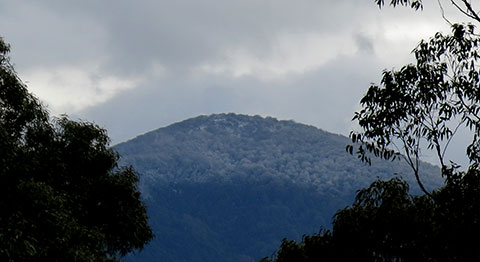Uncategorized
Elegant Parma
If I thought Cremona was grand, Parma is more so. If I’d only associated Parma with ham or Parmesan cheese, I have had a major shift of associations. I now also know Verdi belongs here. It is an elegant midsized city, with many boutiques and parks and cafés. And of course, churches.

This being a personal take on my travels and not a travelogue, I will share glimpses like this one as much as grand buildings. This elderly lady had been feeding the pigeons with bread chunks, much as she would have had in her café latte for breakfast.

Parma is well-maintained, its historic buildings constantly being cleaned and refurbished, as seen on the octagonal Baptistry.

Certainly the Cathedral was grand, but I am finding the gold and arches and frescoes are beginning to blur. I did see a relief sculpture by Benedetto Antelami that was a first in using more natural representations in flow of robes and position of limbs.

This church is especially famous for its groundbreaking Correggio dome fresco, with its unusual perspective, from below, and where for the first the bare legs and implied bare bottom of the Christ are shown. It caused a great stir at the time, but he was truly avant garde and opened the way for others.

I preferred the later Benedictine Monastery, with its simpler lines and central well, where water was drawn that had been collected from the roof.
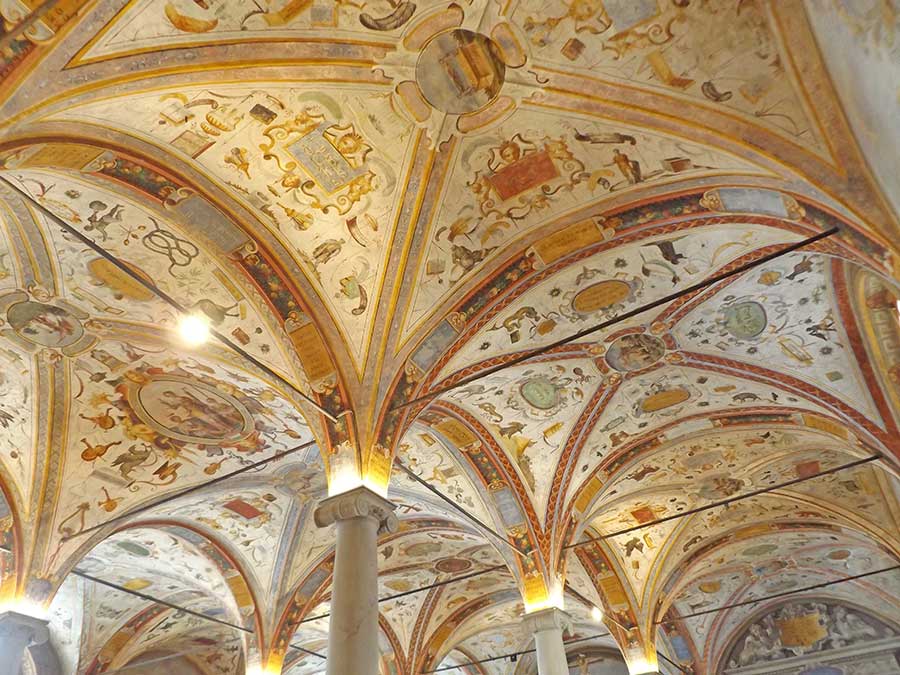
The Monastery has a famous library, with an adjoining room of arches and unusually simple frescoes, commemorating the translation of the bible into the four languages of Latin, Greek, Hebrew, and Syriac.

It does have a church; way too grand for monks, I thought.

In its Correggio dome fresco, of the Vision of St. John (San Giovanni), painted after the infamous one, the perspective is still from below, but the exposure of bare limbs is toned down.
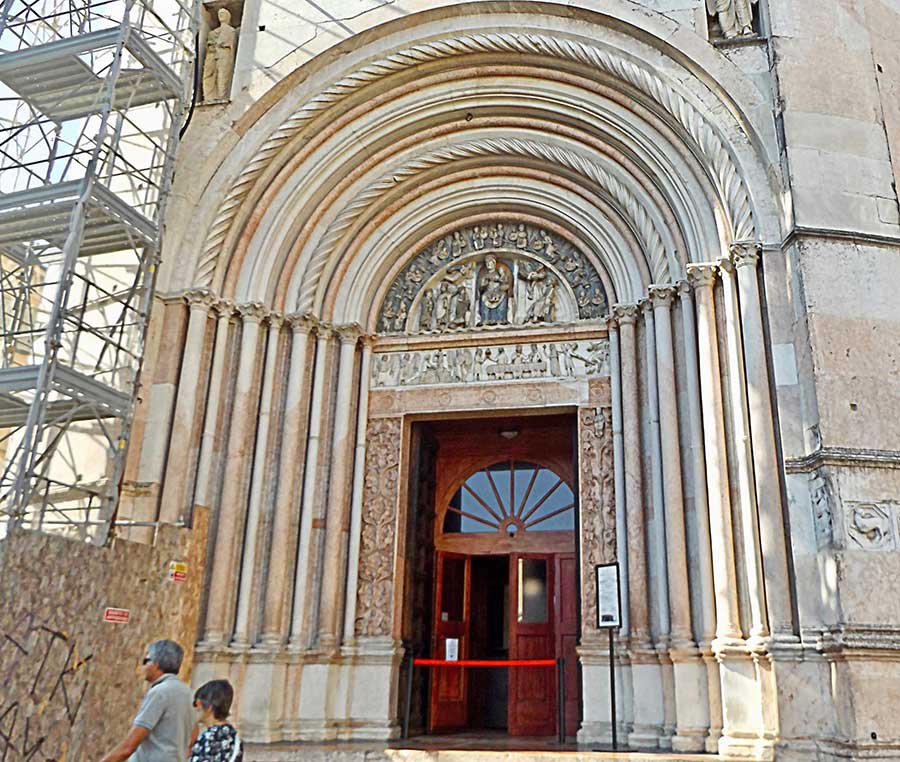
The octagonal Baptistry used lovely pink and white marble from Verona in its construction. Inside, its open space soars to a high frescoed dome, with a central large baptismal font designed for adults. The astrological sculptures, again by the trailblazing Antelami, have been moved from the upper galleries to the ground floor.

But for me the highlight of this building’s treasures is the atypically realistic Madonna and her atypically playful Child.
Lichen decor

On my morning walk, this unusual decorative wall drew me across the road for a closer look. It looked intentional, with the defined cut-off line at the top.

But in fact it was not made by man, but by Nature. It proved to a most painterly smattering of lichens, opportunistically taking over a stretch of black shadecloth.
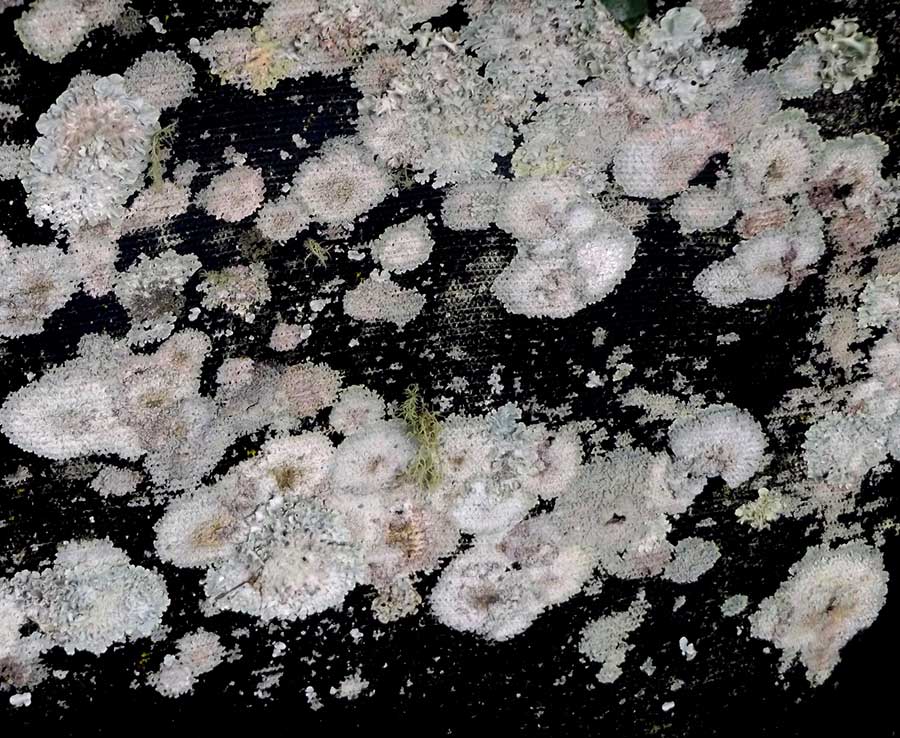
Up close, the lichen was both pretty and delicately varied, the shadecloth host giving it the effect of paint on canvas.
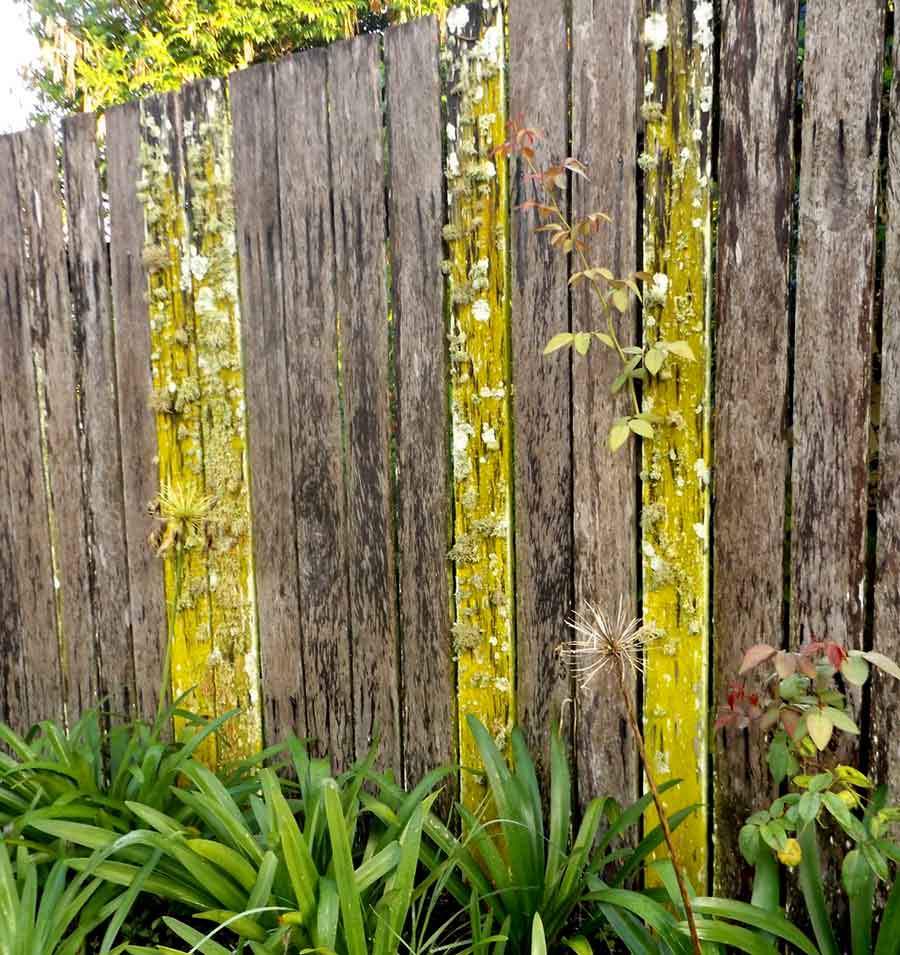
Further along the road, different lichen had ‘painted’ just four of a whole fence of timber palings. What did they have that the others didn’t?

Of course we are most used to seeing lichen on trees, as here on the south side of a palm tree in that same street.
Lichen is not a parasite, so it does not harm the trees.
Lichens are formed from a symbiotic relationship between two organisms — fungus and algae. The fungus grows on the tree and can collect moisture, which the algae needs. The algae, in return, can create food from the energy of the sun, which feeds the fungus.
How clever is that?!
Site work

As Australia burns, I’m staying clear of sunsets and sunrises and anything red, and choosing a cool water photo for this post, although it has nothing to do with what I have to say.
This website has been going since 2007 and is, like me, getting on. Worse than me, it is starting to malfunction. It needs to be totally renewed, so in the interim there will be interruptions and the end result will look different. A clever and very kind friend, Al, is doing this work for me.
Not that I’ve had time to write any posts here since Clive Palmer’s Waratah Coal notified they were making the last moves needed to progress their Galilee Coal mine over my friend Paola Cassoni’s Bimblebox Nature Refuge.
This is my current full time unpaid job — to save Bimblebox — and even though the EDO will represent us in the Land Court, there is much work to be done for them and to raise funds for the battle ahead. If you can help in any way, we’d be grateful…
Nannas sash-on for Water

What better way to mark International Womens Day 2019 than for 120 KNAGs (Knitting Nannas against Gas/Greed) from all over NSW to converge on Sydney to get their message out, ‘United to Protect our Water’.

In a yellow and black tide, red-rimmed for solidarity with their indigenous sisters, they met in Martin Place. I’m an honorary KNAG, but my friend Sharyn O’Dell is a real one, so here’s ‘Sharyn2’ in battle-ready mode.

CBD workers hurried past the converging Nannas, but at the top of the steps from Martin Place station they couldn’t miss the chanting or singing line-up, including the indomitable Bill Ryan.
Nannas from Northern Rivers, Grafton, Gloucester, Coonabarabran, New England North-West, MidCoast, Central Coast, Great Lakes, Hunter, Illawarra and Sydney Loops all wore special sashes bearing the truth that must be faced and acted upon by our decision makers: ‘No Water – No Life’.

Of course Nannas must be perfectly groomed and dressed, to set a good example for the kiddies, as well as saving our land and water for them. Here Judi Summers gets the final touches from Louise Somerville and Clare Twomey.

The Nannas love to get together to catch up on the threats and related actions in their Loops, and are a jolly lot – except that they are deadly serious about what our governments are allowing to happen with our precious water and what they are NOT doing on climate change.
The recent water licence auction in the north-west, where coal companies bid three times what farmers could and hence got the water, shows that our system does not value water for the right reasons. Once more, profit is placed above people and planet.

The ever-persistent protector, researcher and documenter Jo Holden was there (right) here with Julia Lee from the Hunter, with a most poignant sign.

While the KNAGS were kitting up, commuters couldn’t fail to be aware that these Nannas were acting up… as Nanna Felicity made sure with this knitted sign.

Then the Nannas were ready to take the message to the pollies, to Parliament House. They headed up Martin Place, looking dangerously determined – and sounding it. In fact, at the Lismore inaugural KNAGs conference, in my speech I asked for ideas for a collective noun to suit and the consensus was ‘a determination of Nannas’.
Sandwiched in between choruses of ‘No water, no life’ to the tune of Bob Marley’s ‘No Woman, No cry’ was this impassioned chant:
‘Namoi River’s gone, if we don’t act now,
‘Condamine’s gone, if we don’t act now
‘Murrumbidgee’s gone, if we don’t act now,
‘Murray river’s gone, if we don’t act now.’


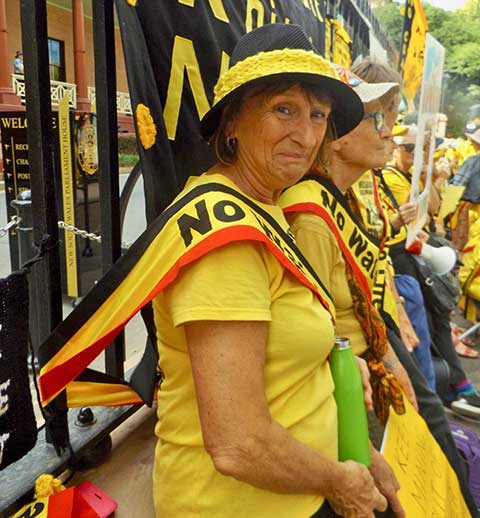
Once there, the whole ‘determination’ of 120 KNAGs tied themselves to the railings, suffragette-style, in a ‘soft lock-on’. They only just fitted along the fence. The police watched on; after all, Nannas are harmless … aren’t they?
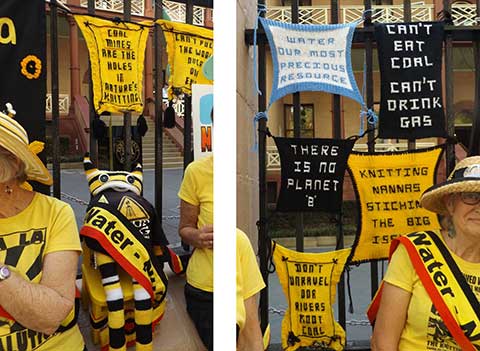
Here they also hung examples of Nanna knitted wit and wisdom, sampler-style.
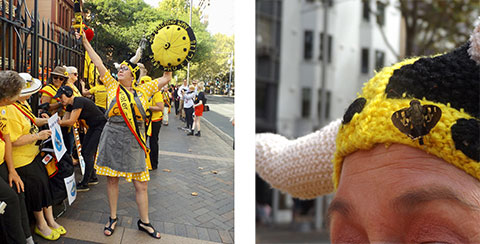
The fearsome Nanna MaryBeth (Brynhildr) from Cairns was there at her most challenging, although this tiny yellow and black insect that chose her helmet did not seem worried. Probably knows the Nannas are saving water for them too.

Young Climate activists, Manjot Kaur (17) and Vivienne Paduch (15), shared in the protest, well protected by Nanna Brynhildr and Nanna Angela Dalu from Lismore, two of the most fierce, funny and friendly Nannas. The girls invited all Nannas to join them in the school strikes on March 15.
Let’s hope enough politicians pay attention to the Nannas’ Knagging List – and that whoever gets in after March 23, they do what their Nannas tell them.
KNAGGING LIST
• Climate action immediately
• Transition to 100% renewables
• End water mining
• Every person to have access to potable water 24/7
• NSW gas ban
• Protect and respect Aboriginal sacred sites
• Protect prime agricultural land
• Create a youth advisory panel
• Revoke anti-protest laws
and ‘Don’t forget to keep your promises’!
Bad moon rising
The last full moon of 2016 first signalled its rising by an eerie backlighting of the many dark clouds that night. Then its round face appeared over the ridge, a glow through thin cloud.

Very soon dark riders and winged demons raced across to begin to quell the growing light.

Woven ropes of clouds were flung across the pale orb until heavier clouds could be brought in to put a total end to such interference with whatever dark deeds were afoot that night.
And yes, I am a fan of Tolkien as well as Creedence Clearwater…
Protecting our wildlife
As many of you know, my last place of 165 acres was a gazetted Wildlife Refuge and protected on my deeds (from all but mining!) under a Voluntary Conservation Agreement with the Office of Environment and Heritage.
My new place is only 5 acres so not eligible for these. However, I was also a member of the Wildlife Land Trust (WLT), and I have now rejoined with this property. The main criterion is that the property be ‘wildlife friendly’ — and that mine sure is.
Once more the Trust’s Evan Quartermain sent me a great sign for the gate, to publicly declare my attitude — and maybe encourage others to join this network of private landowners who care about wildlife and habitat conservation.
Operating under the auspices of the Human Society International, the WLT now has 285 member properties in Australia. It’s free to join, they have a great newsletter and website and can offer advice and help and access to conservation grant applications (as I received at my Mountain for weed control).
I must say my free listing on their property for sale website page created more enquiries about my Mountain than any other source.
Please take a look at their website or contact Evan on 1800 333 737 or email him.
I have mentioned that I am seeing many new birds here. I prefer to see them alive.
This beautiful Green-winged Pigeon is the second bird to die by flying into one of the large glazed sliding doors. Obviously this can’t continue, if my WLT claim of ‘wildlife friendly’ means anything.
I have resorted to a method I learnt from my friends Mike and Sue: feathers stuck in corks and hung outside the windows, to swing and imitate birds, hopefully to warn and divert any avian missiles who can’t see the glass – which they can’t. I know this works, and have passed it on to many. Sometimes I have used side feathers as well on the corks.
My webmaster Fred found this collection of solutions, some of which may suit your situation better.
I do have another sign, but on my gatepost. Just in case any CSG or other extraction company thinks that not having an actual lock on my gate might mean it’s not locked to them.
Their sort of activity would certainly not be habitat or wildlife friendly.
In fact, almost every gate along this road bears this sign; a tribute to the great local awareness-raising work of Manning Clean Water Action Group (MCWAG), and more generally to Lock the Gate. I am a proud member of both.
Mountain symbols
On my last day here on this mountain, nature is turning it all on for me. A little glimpse of the things that symbolise what I love most here.
Wallabies and their joeys were all around, the camellias and bulbs were still in flower, and the bush beyond was glistening with sunshine and dew.
The spring-fed primary perched swamp was full of water, even after the long dry spell, and the mighty ancient Angophora arched out over it as protectively as ever.
Last week there was a light dusting of snow on the higher mountains opposite… very light, but still…
Next week I will be in my new mountainside home, with different wildlife and mountain views — and a creek! — to share with you all. I look forward to sharing my discoveries of its nature.
Hunter air
Wednesday 16th October was pretty windy and smoky; not as much as the following day, when bushfires ran wild and caused so much damage.
I was driving back from Armidale for the Global Mail Coal Wars forum that night in Singleton. If you missed it, you can now watch it online here.
I knew one of the main topics of concern would be the high levels of fine particulate matter in the Hunter’s air — and it was, with Dr John Drinan of the Singleon Healthy Environment Group speaking about that on the panel.
Another topic would be the plight of villages in the path of coal’s apparent runaway expansion.
I’d spotted bushfire smoke over the hills to the west of Muswellbrook, and as I drove through what was once (pre-coal expansion) the village of Ravensworth, I saw what looked at first sight like a big cloud of darkish smoke. Fire?
Nope. I’d forgotten I was back in Coal Country. Just another blast from the mine. The wind gave it good travelling speed as it headed south towards Singleton.
Merely one of the reasons the Hunter has such clean country air.
Brief balm
Instead of my rock orchids flowering to fade to sculptural seed pods as in every other year, by the time I got back after a week away, they had gone! High winds? I wondered.
Nope. Renegade wallaby, spotted in the act, stripping each stem of blossoms.
Why, when never before?? I will never know why such apparent perversity manifests itself, but I hope this is a once-off!
But if my green surrounds and its blossom bounty helps me recover in between bouts of talks, so it does for many others. At the 350 degrees Divestment Forum in Sydney I’d met Georgia from The Green B, another rural convert, and we swapped website addresses.
As I think my readers would like hers, the link will now be permanent here.
Since then, I’ve received video links to those talks, so here’s mine.
There’s since been another Forum in Hobart and 350.org will be hosting further forums over the coming month.
Full details can be found by clicking on the linked events below and in the attached flyers.
Perth — To be advised
And while I’m putting my ‘house’ in order here for summer, my Gypsy camper also now has better accommodation, with shade sail for hail or harsh sun, a trickle solar charger for its battery, and cement strips for my ute to find its way to connect more easily.
Quiet coastal surprises
Tomaree National Park at Port Stephens, New South Wales, is a delightful coastal forest of banksias, angophoras and eucalypts, with spiky low palms, all holding the white sand dunes in place.
After a week of rain, while walking along its tracks to the beach, the variety of fungi was a surprise.
They were mostly just poking through in the damp leaf litter, and my five-year-old granddaughter proved a top fungi spotter.
I am assuming the one pictured above is some sort of coral fungi, but I couldn’t find one this colour in my books.
In fact, these coastal forest fungi proved most elusive when it came to my usual non-scientific attempts at identification — poring over the drawings and photos and browsing the texts.
I’d have thought this orange number would have been easy, with such a prominent crown to the broad-brimmed hat, but no luck.
I wonder if it can be the one commonly called the Ghoul Fungus (Hebeloma aminophilum), because it grows on soil fed by ‘the rotting corpses of dead animals and even thrown-away bones’ (A.M. Young, ‘A Field Guide to the Fungi of Australia’). It has been recorded in eucalypt forest, although not in NSW, or not officially.
This one I think is my old mate that I call the tomato fungi, which I have seen on my mountain. That was suggested by my fungi guru Gaye Drady to be Russula aff. rosacea.
Looking up this one on Gaye’s site, maybe it’s the Ghost Fungus (Omphalotus nidiformis) which is luminous, so glows in the dark. Gaye says they can grow up to 200m diameter and ‘are found on living and dead wood, both native and exotic, and can often be found in gardens and parks.’
Whatever the little fungus underneath is, it was the frothy ice cream topping that caught my eye. Once more I turned to Gaye and it looks like it’s a species of parastic fungus, Spinellus.
What a weird and wonderful world is at our feet if we are truly alert to our surroundings. And how lucky we are that others like Gaye study these extraordinary organisms and share that knowledge so freely.
North West awakening
I’m back home after a week in North-West NSW. I was there for the NorthWest Alliance of community groups across the Walgett, Moree, Narrabri, Coonamble, Gunnedah, Coonabarabran, Quirindi and Tamworth shires — all very concerned about the expansion of extractive industries there, especially coal and coal seam gas.
We were a trio at information forums in Tamworth, Gunnedah, Narrabri and Moree.
Mark Ogge from The Australia Institute spoke on the economic impacts, on agriculture especially, launching a new report, ‘Still beating about the bush’, I spoke on the social impacts, and Dr Steve Robinson from Gloucester and Doctors for the Environment, spoke on health impacts.
While issues were different in each place, interest was clearly high everywhere as good attendances (80-160) and keen questions showed. Eight times the current coal production is predicted for the Gunnedah Coal Field, as it is called overall, and CSG companies like Santos are well entrenched and keen to get going.
This is a major agricultural cropping region, proud of its water-retaining black soils, and most people want to keep it that way.
Tamworth may not be immediately threatened but I feel it could well become a Drive-in, Drive-out (DIDO) centre, where workers base their families, near amenities and away from the inevitable pollution if projects like those recently ticked off by Mr Burke go ahead — the Maules Creek mine and the Boggabri expansion. People also expressed concern about the role of coal in fuelling global warming.

Gunnedah worries about both coal and CSG, being near the BHP Billiton Caroona EL, the Shenhua Watermark EL and the Santos leases, given what we have seen in the Pilliga Forest gas fields, where spills like the above give good reason to be worried. (See Stop Pilliga Coal Seam Gas.) It also has the Whitehaven coal stockpiles and processing plant nearby.
Santos opened their ‘shop’ in Gunnedah’s main street last week, matched by a far more informative shopfront almost next door, of the N-W Alliance.
The main current coal expansion is around Boggabri, roughly halfway on the Newell Highway north from Gunnedah to Narrabri. Boggabri is soon to get a single persons worker accommodation camp, as Narrabri already has. Gunnedah wants residential housing instead.
I fear for Boggabri’s future, for health and social reasons.
Narrabri Council has been and still is gung-ho in favour of these industries, with the Pilliga CSG fields between here and Coonabarabran, and the Whitehaven coal stockpiles not far away. Clearly not all the community agree.
To the north, Moree Council has stood up for their region to remain agricultural, not industrial. They also have the shining example of the Bellata/Gurley group who have stood united against allowing CSG exploration on their top cotton and wheat land, ‘locking their gates’ well in advance.

At the last three talks, I was greatly encouraged by the number of Gomaroi people who came, and who spoke up for the need for a united front to save our land and the water. The eloquent Alf Priestley at Moree moved many by his words about one human race.
At Moree I was also privileged to meet Auntie Shirley (front, above), the last person born at Terry Hie Hie, a mission, but also a very special place for the Gomaroi, who would be devastated to lose others like Leard Forest. As I showed her to a front row seat I felt like I was escorting royalty.
At chairperson Penny Blatchford’s enquiry, hands were raised in an overwhelming majority indication of wishes for a CSG-free community (Aunty Shirl certainly agrees, but is a little hard of hearing).
Further action meetings were planned in all four towns: the North-west will be an area to watch.
Next event in the region is the Leard Forest Listen Up on March 9-10, at the Frontline Action camp. See this good update from the camp and links about the event here.







